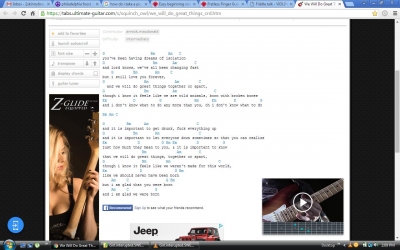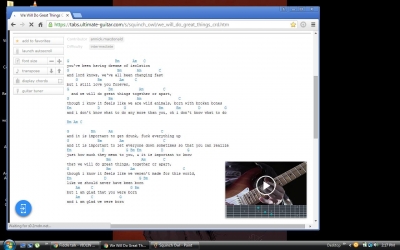Welcome to our forum. A Message To Our New and Prospective Members . Check out our Forum Rules. Lets keep this forum an enjoyable place to visit.
Currently working on errors from the latest (SimplePress) forum update. Many issues have been resoled and others are being worked on. Thank you for your patience.
 Topic RSS
Topic RSS



 (0 votes)
(0 votes) Regulars
 Offline
Offline

You could do something as simple as just playing the root notes of the chord - for example, G for the G chord. Or you could try arpeggios based on the chords and done to a suitable rhythm. for example, experiment with G B D G where it says G chord. You could try taking the arpeggio notes up and back down, or you could do something like a base line: G B D B (go up from g to b to d and back to b). Experiment to see what you like best.
What I would actually do us listen to the song repeatedly and try to figure out the notes of the melody. The notes of the chords will give you a starting point to work from, but the melody will probably also have notes not in the chords.
Members
 Offline
Offline





Probably the easiest way to do it for guitar chords commonly found in pop/rock music is to just play the root and 5th as a "doublestop" for the chords. Basically just playing 2 strings that are next to each other and holding them down at the same finger position with one finger.
I don't know how much of a beginner you are, so I'll explain a bit, and assume only that you know (or can find out) notes on the violin.
So from your first example, the G chord for guitar. You can play the open G string and D string to get the root (G) and 5th (D). Easy one there, the finger position would be "zero".
For the Bm (B minor) you'd put your second finger down on the same strings so your second finger holds down the note B on your G string, and F# on your D string. That will give you the root and 5th for the Bm chord.
Playing just the root and 5th, you don't need to worry about whether the chord is major or minor or 7th, etc. All the guitar chords you are *likely* to run into in 99.9% of pieces all use the root note and the 5th note, so it will fit if you're playing with other people or maybe just accompanying yourself to sing along or make a backing track to play along with.
If that is too easy and/or you want more options, mandolins are tuned the same as violins, so you can check a mandolin chord finder to get more note options to experiment with..
http://www.all-guitar-chords.c.....ndolin.php
Just remember that the mandolin frets are half steps, and not the violin or fiddle finger positions. Any violin or fiddle chart that shows the fingerboard with ALL the note (including sharps and flats) can help you translate it to violin finger positions, if you find the frets a bit confusing at first.
Hope that helps?
"This young wine may have a lot of tannins now, but in 5 or 10 years it is going to be spectacular, despite the fact that right now it tastes like crude oil. You know this is how it is supposed to taste at this stage of development." ~ Itzhak Perlman
1 Guest(s)


 Log In
Log In Register
Register











